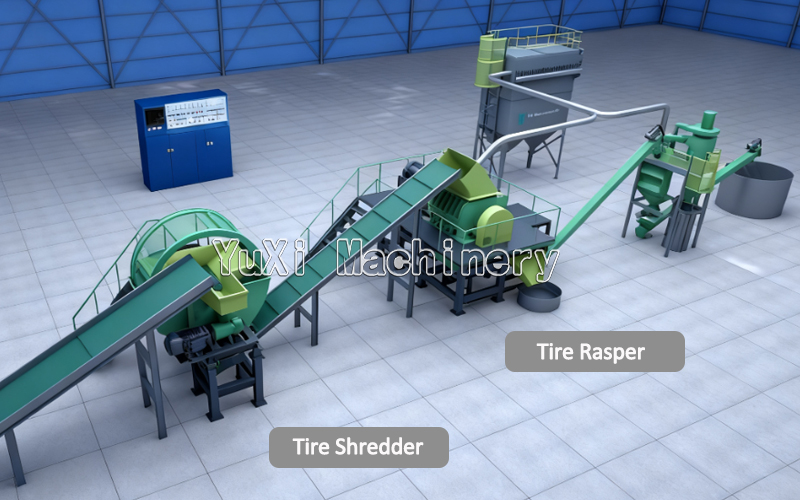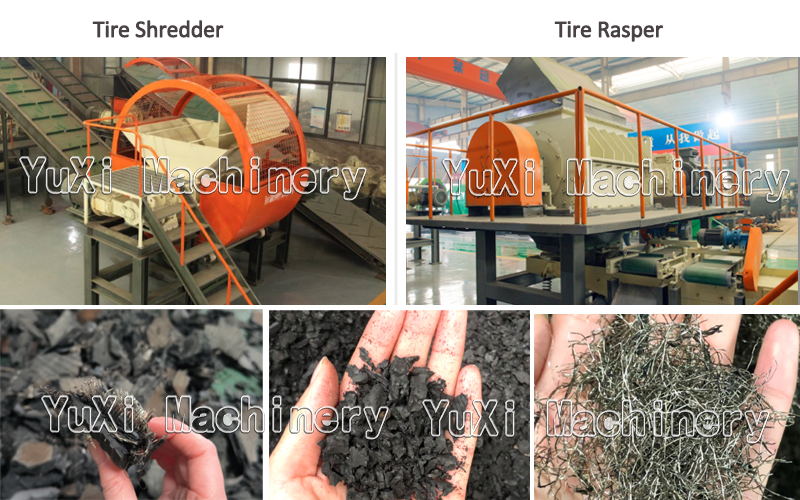In the global trend of environmental protection and resource recycling, the disposal of waste tires has always been a challenging issue. Piles of tires not only occupy land but also release harmful substances. At the same time, they are a “urban mine” rich in valuable rubber and steel wires. Today, we will delve into the tire wire separation system to see how it transforms waste tires into valuable resources.

The tire wire separation system is the core component of waste tire recycling, converting entire tires into reusable resources through three main steps: shredding—separation—purification.
1.Feeding and Initial Shredding
Entire waste tires are first conveyed into a Tire Shredder. Under strong shear forces, tires are broken into small pieces, preparing them for subsequent fine separation. The key here lies in the shredder’s blade design and power configuration, ensuring efficient handling of various tire types.
2.Fine Shredding and Initial Separation
The shredded rubber pieces enter a Tire Rasper, where most steel wires are separated from the rubber through high-speed impact and friction. This step improves separation efficiency and lays the foundation for subsequent magnetic separation and purification. The rasper’s rotational speed, blade material, and arrangement all affect separation efficiency and the uniformity of rubber granules.
3.Magnetic Separation and Purification
The separated mixture passes through a high-intensity magnetic separator, where steel wires are automatically separated and collected, resulting in clean recycled steel wires. The rubber is further processed into uniformly sized 30mm granules. Key parameters affecting separation purity include the magnetic field strength, drum speed, and tilt angle of the separator.

1.Tire Shredder
2.Tire Rasper
3.Magnetic Separator
1.High Separation Rate
Unique separation technology ensures a steel-rubber separation rate exceeding 99%, yielding high-purity, high-value products. This means nearly all steel wires can be recovered, significantly improving resource utilization.
2.High-Quality Products
3.Energy Efficiency
Scientific power configuration and streamlined process design ensure high output (500–15,000 kg/h) while maintaining low energy consumption. Energy use is reduced by over 20% compared to traditional processes.
4.Automation and Intelligence
The system uses PLC control for fully automated operation, reducing manual intervention and improving production stability and safety. Some advanced systems also incorporate AI vision recognition to further optimize separation results.

1.Environmental Value
The tire wire separation system effectively addresses waste tire accumulation, reducing land occupation and environmental pollution, and supporting circular economy and sustainable development. Statistics show that processing 10,000 tons of waste tires reduces land occupation by approximately 30,000 m³ and carbon emissions by about 5,000 tons.
2.Economic Value
3.Social Value
The system creates jobs, promotes green industry development, and raises environmental awareness. It also supports the construction of “zero-waste cities.”
4.Policy and Market Prospects
As global emphasis on environmental protection and resource recycling grows, countries are introducing policies to support waste tire recycling. The global tire wire separation system market is expected to grow at an annual rate of over 15% in the next five years.
A tire recycling plant in an industrial park introduced an advanced tire wire separation system. Since commissioning, the system has operated stably, meeting or exceeding design specifications:
1.Technological Innovation
2.Industrial Chain Extension
3.Global Expansion
As vehicle ownership rises in developing countries, demand for waste tire disposal will grow rapidly, shifting market focus to emerging markets.
The tire wire separation system is not just a technological innovation but a shift in mindset—seeing “waste” as misplaced “resources.” With technological progress and policy support, waste tires will continue their impressive transformation, contributing to a more beautiful planet.
